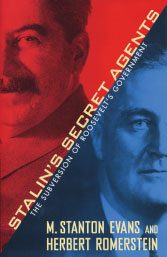
Stalin’s Secret Agents: The Subversion of Roosevelt’s Government, by M. Stanton Evans and Herbert Romerstein, New York: Threshold Editions, 2012, 304 pages, hardcover.
“Communists and fellow travelers on official rosters in case after case were agents of the Soviet Union, plighting their troth to Moscow and striving to promote the cause of the dictator Stalin,” write M. Stanton Evans and Herbert Romerstein in their new book, Stalin’s Secret Agents: The Subversion of Roosevelt’s Government. They make the case that while the United States was allied with Josef Stalin’s Soviet Union against Nazi Germany and Fascist Italy in World War II, the government of President Franklin Delano Roosevelt was heavily infiltrated by members of the Communist Party USA and other pro-Red operatives. These communists and Soviet agents were, according to the authors, working to sabotage U.S. policy in favor of the interests of Moscow.
“This is of course contrary to the notion that American Reds were simply idealistic do-gooders, perhaps a bit misguided but devoted to peace and social justice, and thus shouldn’t have been ousted from government jobs just because of their opinions,” Evans and Romerstein acknowledge. Yet, they maintain: “In countless instances, we know that domestic Communists in official posts were actively working on behalf of Russia, and thus were the minions of a hostile foreign power.” Evans and Romerstein provide ample documentation to make their case.
Among the resources Evans and Romerstein drew from are the declassified Venona decrypts. These decrypts were originally compiled by the U.S. Army Signal Corps, which monitored the secret communiqués between the Soviet Union and their spies in America in the 1940s. These files were declassified by the U.S. government in 1995, and have since provided additional evidence to the claims made by Sen. Joseph McCarthy and other anti-communists in the 1950s of individuals suspected of having been in the Communist Party and working for Moscow.
The authors also draw from once-confidential documents of the FBI, which tracked and recorded the activities of communists and Soviet agents as early as the 1930s, and the personal papers of FDR Secretary of State Edward Stettinius. Further documented materials were also accessed from declassified Soviet and other Eastern-bloc archives, as well as the recently disclosed Vassiliev papers.
Named after former KGB intelligence operative Alexander Vassiliev, who defected to the United Kingdom in 1996, the Vassiliev papers are a collection of eight notebooks and loose pages kept by Vassiliev while researching in the KGB archives. His research was originally conducted as part of an SVR (Russian external intelligence service, successor to the KGB) book project on Soviet espionage in America. When Vassiliev defected to the U.K., he took his papers with him and donated the original copies to the Library of Congress, where they currently reside.
Using these and other sources, Evans and Romerstein leave no doubt that the amount of communist and pro-Soviet penetration of the U.S. government during World War II and the early years of the Cold War was extensive. Communist penetration, as they outline in their book, extended into the Departments of Agriculture, Commerce, Interior, State, Treasury, and War, as well as the OSS (Office of Strategic Services, precursor to the CIA), the Foreign Economic Administration (FEA), the Farm Security Administration (FSA), and the White House.
This is a history that has commonly been overlooked or minimized in its importance by prevailing academics and scholars, who continue to dismiss the idea that there was any such communist penetration of the government or, if they acknowledge it at all, claim it was minuscule at most.
Horrible Hopkins
Using all of the aforementioned sources, Evans and Romerstein are able to provide a refreshingly honest account of the communist subversion in Roosevelt’s government. Among the various communist and other pro-Red apparatchiks in the FDR government was Harry Hopkins, who served as the secretary of commerce under Roosevelt. Hopkins was also FDR’s closest advisor and a major architect of the New Deal. During the war, he was Roosevelt’s key advisor on U.S. relations with the Soviet Union and was at FDR’s side at the Yalta wartime summit between Churchill, Roosevelt, and Stalin in 1945.
During the Yalta summit, a deadlock occurred over the issue of “reparations,” or monetary repayment for the war damages inflicted on the Allied powers, particularly to the Soviet Union. At this point Hopkins passed a handwritten note to Roosevelt that read: “Mr. President, the Russians have given in so much at this conference I don’t think we should let them down. Let the British disagree if they want — and continue their disagreement at Moscow.”
Ironically, it was not Stalin who had made concessions at Yalta. In fact, even FDR loyalists applaud Roosevelt for agreeing to give the Soviet Union three votes in the still-to-be-created UN General Assembly as a supposed diplomatic victory for “winning” Stalin’s support for creating the UN. After gaining Stalin’s promise to declare war on Japan, “FDR agreed to a vast array of benefits for Moscow.” These included “sanctioning Soviet control of Outer Mongolia, ceding to Russia the southern part of Sakhalin Island north of Japan and the Kurile chain that stretches between Japan and Russia, plus de facto control of seaports and railways in Manchuria, the main industrial zone and richest part of China,” Evans and Romerstein write.
As Evans and Romerstein note, Hopkins was complicit in the communization of Poland and Eastern Europe. Though at the outset of WWII the Soviets were partnered with the Nazis in the invasion of Poland, Stalin insisted to western Allies that he be allowed to keep the territories seized by the Red Army and allowed to liquidate elements in Poland, as reparations. To these proposals, Hopkins sided with Stalin. When anti-communist Polish-Americans attempted to protest what they saw as the communization of their native homeland, Hopkins and his staff hindered their efforts. The authors provide further details about this betrayal in their book.
Furthermore, in the spring of 1945, following Roosevelt’s death, Hopkins remained in the White House and was sent to Moscow by newly sworn-in President Harry Truman in order to “reassure” Stalin and the Soviets of the United States’ non-belligerence toward Moscow and its post-war Soviet interests. At the Hopkins-Stalin meeting, when Stalin aggressively stated that the British did not want a “Poland friendly to the Soviet Union,” Hopkins responded, as he did at Yalta, that the U.S. position was different from Britain’s. Hopkins said, “The United States would desire a Poland friendly to the Soviet Union, and in fact desired to see friendly countries all along the Soviet borders.” Stalin replied, “if this be so we can easily come to terms regarding Poland,” which would in fact turn out to be the case as the USSR established a puppet communist regime there under the de-facto control of the Soviet Union without a shot being fired. Evans and Romerstein do not provide a detailed account as to how Hopkins influenced Truman’s policies in regard to the Russians, but claimed that it was Hopkins’ pro-Soviet sympathies that led Truman to abandon Poland to the mercy of Stalin.
Also noted by Evans and Romerstein is a Venona entry concerning a Roosevelt-Churchill meeting from May 1943, in which a Soviet informant, identified as “No. 19,” told the Russians via a KGB (then NKVD) report of what the two leaders discussed. The message suggests that “No. 19” was in the room at the time of the conference, and since Hopkins was the go-between person for Roosevelt and foreign leaders, such as Churchill, it is plausible to believe that No. 19 was in fact Hopkins.
The authors further note that KGB defector Oleg Gordievsky identified Hopkins as a Soviet intelligence agent, and veteran KGB operative Iskhak Akhmerov claimed that Hopkins was “the most important of all Soviet wartime agents in the United States.” Evans and Romerstein also reveal how “Hopkins was instrumental in blocking U.S. and British aid to Polish fighters who at the instigation of the Russians had risen up against the Nazis occupying Warsaw.” The Soviets encouraged the Poles to rise up against the Nazis only to let both the Poles and Nazis slaughter each other without any Allied intervention. The authors suggest that the Soviet Union was anxious to see both sides finish each other off, in order to secure an eventual Soviet victory over both the Nazis and Poland, with as few Red Army casualties as possible. Stalin’s Secret Agents provides further detail of Hopkins’ subterfuge and other subversive activities within the Roosevelt administration, as well as his ties with other pro-communist agents of influence around the president.
Bit of a Speedbump
There are a couple flaws with the book. The authors presume that Soviet or Russian spying and subversion no longer take place. The authors fail to explain how this penetration ended, if it ever did. The reader must suppose that those spies and subversives merely faded out of history. The authors also promote the mainstream viewpoint that the collapse of the Soviet Union put an end to the threat of communism from Moscow, which is contrary to the Anatoly Golitsyn theory — and conflicts with ever-emerging evidence — that the collapse of communism and subsequent fall of the Soviet empire was a staged KGB deception. Furthermore, the book itself, as a whole, is written for someone who has forehand knowledge of the accusations of communist and Soviet espionage during World War II, and who is familiar with many of the names of individuals mentioned.




